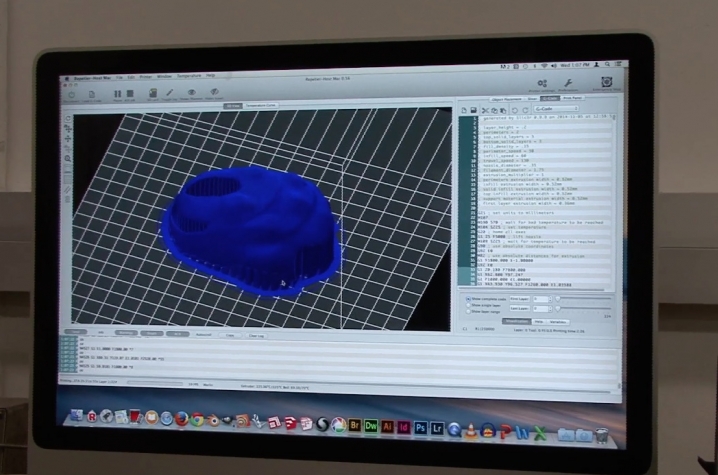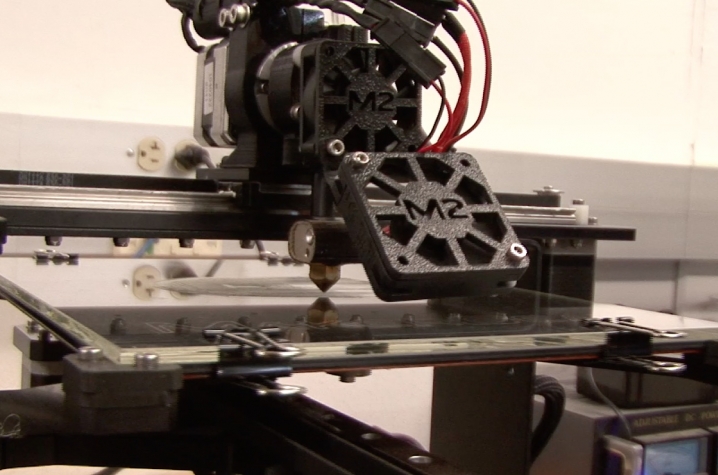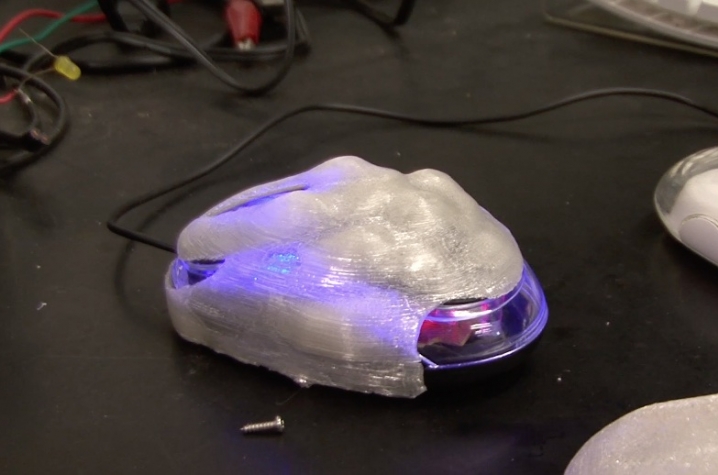UK Art Goes 3D
[youtube]
Video by Jenny Wells/UK Public Relations and Marketing
LEXINGTON, Ky. (Dec. 5, 2014) – As the Smithsonian Castle begins displaying the first 3D-printed bust of a U.S. President, students in one University of Kentucky art course are wrapping up a semester learning how to not only create art with the assistance of a 3D printer, but also to build 3D printers.
The concept for the new course came from a suggestion by Derek Eggers, senior faculty instructional consultant with UK's Center for Enhancement of Learning and Teaching (CELT), and Jeremy Colbert, a facilities specialist in metal arts at UK School of Art and Visual Studies. Eggers then teamed up with senior lecturer James Wade, in sculpture and art foundations, to design a 3D printing course that would teach students to not only use the printer but also build one, capitalizing on the wealth of open source information available.
"We initially hoped to create machines from scratch. But we wanted to emphasize creativity first and foremost," Wade said. "We realized by using kits, a lot of the highly technical issues involved with such delicate precision machines had been problem solved by other tech labs."
Initially imagined for model making and prototyping, opportunities to use 3D technology have boomed in recent years. More and more, the forms produced by printers can now be used as the final product. And the industry is pushing the realm of possibilities even further by transforming them into other materials using casting and mold making processes, making this another tool in the inventory.
Egger and Wade's course,"A-S 390: Hybrid Fabrication," includes not only the creation of art or other "artifacts," but also construction of two 3D printers from kits and one CNC router/mill from a kit. The class is cross disciplinary and open to all majors with the goal of creating interaction between several departments and colleges on campus — engineering, art, media, agriculture and design.
Students started the course with learning the digital drawing program called Rhino3D. Once a basic understanding of drawing was achieved by each student, they then pursued their own designs. Art majors were pushed to create forms that complement the work they are doing in other studios. Students in other areas were encouraged to create forms or 'artifacts' that relate to their areas of study, like parts for the UK Solar Car.
"So an engineering student might design a mechanical part rather than a sculpture," Wade said. "These designs are then printed on 3D printers, cut on a CNC laser cutter, or milled on a CNC router. Some designs will be taken to the foundry in the Metal Arts facility and cast in aluminum or iron."
In the end, the technology lets users build anything from a tool (like a part of an easel), to just one element of a piece of art, to an entire artwork itself or multiple art pieces with minor differences in a series of work.
After learning how to input the piece they needed, students then teamed up and began to assemble the two different printers and the CNC router. Eggers and Wade hope learning how to build the printers will give students an even better idea of the 3D printing technology.
"Building the machines should demystify the idea of 3D printing and CNC technology," Wade said. "Some students from engineering and other colleges know what this type of equipment can do but don't necessarily get to have the hands-on experience. For most students in the School of Art and Visual Studies, this is an entirely new experience. We want to make the processes approachable."
Art studio senior Melissa Shelton, from Hopkinsville, Kentucky, was excited with the skills she picked up in the course.
"It was a lot more hands on than most art studio classes get to take part in. It was definitely really interesting to see kind of how it all worked together. I think that gave me a better understanding of how 3D printing works to begin with," Shelton said. "They have three different axes, and we had to build motors for each one of those. So you really get to see how it goes up, it moves over, and then back down, and it goes all the way through space. That was cool."
In addition, the assembly knowledge should help with creation of future designs. "Knowing the mechanics, movements, parameters and software of the machines will inform them of what is possible to achieve," Wade said.. "There are limitations in the processes, so there is problem-solving involved with design choices."
Wade, an artist and former mechanical engineering student who worked in 3D modeling programming at IBM, believes the new skills acquired by the UK students should make them more marketable in their career fields.
"A lot is happening in the so called 'Maker Movement.' Technology is becoming more affordable and therefore more common in the public realm," he said. "Up until 2010, this was only something that could be utilized in industry, with $40k+ equipment. Use of 3D digital technology is extremely useful in industry, engineering, architecture, design, studio arts and more."
Shelton agrees it is valuable for all art mediums, not just sculpting, which 3D printing lends itself to naturally. "I am originally a painter. I am really interested in 2D design, but I wanted to get outside of my normal artistic range and I thought that 3D printing is kind of trendy and in technology in the world today, so I wanted to get some skills for that professionally."
After achieving much success and interest in the first presentation of this course, Wade and Eggers will teach the course again in the spring, "A-S 546: Digital Design and Fabrication." In addition, the class is also being used to understand the campus needs of 3D printing resources. The new Bolivar Art Center will use this information to help set up a new FabLab when the building opens in the summer of 2015. The School of Art and Visual Studies plans to operate the lab for students across campus.
Individuals wanting to see some of the results of Wade and Eggers' course, can check out the students' work at two upcoming events. Work will be on display at Open Studio being presented from 6 to 9 p.m. tonight, Dec. 5, at Reynolds Building Number 1. The following week the students' work will be the focus of an exhibition on display 6 to 9 p.m. Thursday, Dec. 11, at the Tuska Center for Contemporary Art, located in the Fine Arts Building.
The UK School of Art and Visual Studies in the UK College of Fine Arts is an accredited member of the National Association of Schools of Art and Design and offers undergraduate and graduate degrees in the fields of art studio, art history and visual studies and art education.
CELT was created as a way of highlighting educational development resources and services available to UK instructors. The center works with instructors to create engaging, innovative and inclusive learning environments in which diverse students can excel.
MEDIA CONTACT: Whitney Hale, 859-257-8716; whitney.hale@uky.edu








